United States Department of Commerce
In the United States, the Department of Commerce is an executive department of the federal government concerned with promoting economic growth. Among its tasks are gathering economic and demographic data for business and government decision-making, and helping to set industrial standards. This organization's main purpose is to create jobs, promote economic growth, encourage sustainable development and block harmful trade practices of other nations.[3] The Department of Commerce headquarters is the Herbert C. Hoover Building in Washington, DC. Wilbur Ross is the current Commerce secretary.
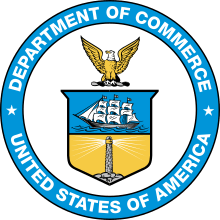 Seal of the U.S. Department of Commerce | |
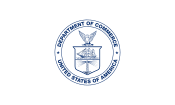 Flag of the U.S. Department of Commerce | |
 The Herbert C. Hoover Building, the headquarters of the U.S. Department of Commerce | |
| Agency overview | |
|---|---|
| Formed | February 14, 1903 |
| Jurisdiction | United States of America |
| Headquarters | Herbert C. Hoover Building 1401 Constitution Avenue NW, Washington, D.C., U.S. 38°53′39″N 77°0′58″W |
| Employees | 46,608 (2018)[1] |
| Annual budget | US$9.67 billion (2018) US$14.2 billion (est. 2010) US$9.3 billion (est. 2011) US$8.6 billion (2014)[2] |
| Agency executives |
|
| Website | www |
| Footnotes | |
History
Organizational history
The department was originally created as the United States Department of Commerce and Labor on February 14, 1903. It was subsequently renamed the Department of Commerce on March 4, 1913, as the bureaus and agencies specializing in labor were transferred to the new Department of Labor.[4]
The United States Patent and Trademark Office was transferred from the Interior Department into Commerce, and the Federal Employment Stabilization Office existed within the department from 1931 to 1939. In 1940, the Weather Bureau (now the National Weather Service) was transferred from the Agriculture Department, and the Civil Aeronautics Authority was merged into the department. In 1949, the Public Roads Administration was added to the department due to the dissolution of the Federal Works Agency.[4]
In 1958, the independent Federal Aviation Agency was created and the Civil Aeronautics Authority was abolished. The United States Travel Service was established by the United States Secretary of Commerce on July 1, 1961, pursuant to the International Travel Act of 1961 (75 Stat. 129; 22 U.S.C. 2121 note)[5] The Economic Development Administration was created in 1965. In 1966, the Bureau of Public Roads was transferred to the newly created Department of Transportation. The Minority Business Development Agency (MBDA) was created on March 5, 1969, originally established by President Richard M. Nixon as the Office of Minority Business Enterprise. The National Oceanic and Atmospheric Administration (NOAA) was created on October 3, 1970.[4]
Herbert Hoover as secretary of commerce
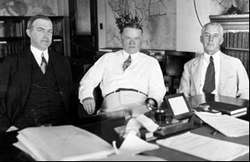
Herbert Hoover, 1921–28 was by far the most active secretary in the history of the department.[6]
After his election as president in 1920, Warren G. Harding rewarded Hoover for his support, offering to appoint him as either Secretary of the Interior or Secretary of Commerce. Secretary of Commerce was considered a minor Cabinet post, with limited and vaguely defined responsibilities, but Hoover, emphasizing his identity as a businessman, accepted the position. In sharp contrast to the Interior Department, there were no scandals at Commerce.[7]
Hoover envisioned the Commerce Department as the hub of the nation's growth and stability.[8] His experience mobilizing the war-time economy convinced him that the federal government could promote efficiency by eliminating waste, increasing production, encouraging the adoption of data-based practices, investing in infrastructure, and conserving natural resources. Contemporaries described Hoover's approach as a "third alternative" between "unrestrained capitalism" and socialism, which was becoming increasingly popular in Europe.[9] Hoover sought to foster a balance among labor, capital, and the government, and for this he has been variously labeled a "corporatist" or an associationalist.[10]
Hoover demanded, and received, authority to coordinate economic affairs throughout the government. He created many sub-departments and committees, overseeing and regulating everything from manufacturing statistics to air travel. In some instances he "seized" control of responsibilities from other Cabinet departments when he deemed that they were not carrying out their responsibilities well; some began referring to him as the "Secretary of Commerce and Under-Secretary of all other departments."[8] In response to the Depression of 1920–21, he convinced Harding to assemble a presidential commission on unemployment, which encouraged local governments to engage in countercyclical infrastructure spending. He endorsed much of Mellon's tax reduction program, but favored a more progressive tax system and opposed the treasury secretary's efforts to eliminate the estate tax.[11]
Radio and travel
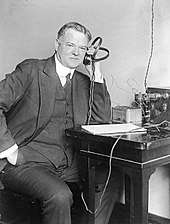
When Hoover joined the department, almost no families had radios; when he became president in 1929, 10 million owned one, and most of the rest listened in a nearby home, store or restaurant. Hoover's department set the policies that shape the entire new industry. Hoover's radio conferences played a key role in the organization, development, and regulation of radio broadcasting. Hoover also helped pass the Radio Act of 1927, which allowed the government to intervene and abolish radio stations that were deemed "non-useful" to the public. Hoover's attempts at regulating radio were not supported by all congressmen, and he received much opposition from the Senate and from radio station owners. [12][13][14]
Hoover was also influential in the early development of air travel, and he sought to create a thriving private industry boosted by indirect government subsidies. He encouraged the development of emergency landing fields, required all runways to be equipped with lights and radio beams, and encouraged farmers to make use of planes for crop dusting.[15] He also established the federal government's power to inspect planes and license pilots, setting a precedent for the later Federal Aviation Administration.[16]
As Commerce Secretary, Hoover hosted national conferences on street traffic collectively known as the National Conference on Street and Highway Safety. Hoover's chief objective was to address the growing casualty toll of traffic accidents, but the scope of the conferences grew and soon embraced motor vehicle standards, rules of the road, and urban traffic control. He left the invited interest groups to negotiate agreements among themselves, which were then presented for adoption by states and localities. Because automotive trade associations were the best organized, many of the positions taken by the conferences reflected their interests. The conferences issued a model Uniform Vehicle Code for adoption by the states, and a Model Municipal Traffic Ordinance for adoption by cities. Both were widely influential, promoting greater uniformity between jurisdictions and tending to promote the automobile's priority in city streets.[17]
Other Hoover initiatives
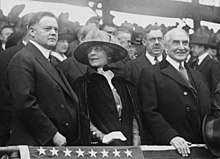
With the goal of encouraging wise business investments, Hoover made the Commerce Department a clearinghouse of information. He recruited numerous academics from various fields and tasked them with publishing reports on different aspects of the economy, including steel production and films. To eliminate waste, he encouraged standardization of products like automobile tires and baby bottle nipples.[18] Other efforts at eliminating waste included reducing labor losses from trade disputes and seasonal fluctuations, reducing industrial losses from accident and injury, and reducing the amount of crude oil spilled during extraction and shipping. He promoted international trade by opening overseas offices to advise businessmen. Hoover was especially eager to promote Hollywood films overseas.[19]
His "Own Your Own Home" campaign was a collaboration to promote ownership of single-family dwellings, with groups such as the Better Houses in America movement, the Architects' Small House Service Bureau, and the Home Modernizing Bureau. He worked with bankers and the savings and loan industry to promote the new long-term home mortgage, which dramatically stimulated home construction.[20] Other accomplishments included winning the agreement of U.S. Steel to adopt an eight-hour workday, and the fostering of the Colorado River Compact, a water rights compact among Southwestern states.[21]
Foreign economic policy
The department has always been involved in promoting international non-financial business.[22] It stations commercial attaches at embassies around the world. Currently the key sub agencies are the International Trade Administration, and the Bureau of Industry and Security. The ITA provides technical expertise to numerous American companies, helping them adjust to foreign specifications. It provides guidance and marketing data as well. The Office of Export Enforcement administers export controls, especially regarding the spread of nuclear technology and highly advanced electronic technology.[23] Under the administration of President Donald Trump, the policy has been to restrict high-technology flows to China. From 1949 to 1994, the department worked with the 17-nation Coordinating Committee on Multilateral Export Controls, which restricted technological flows to the Soviet Union and other communist nations. Since 1980, the Commerce Department works to neutralize the dumping of exports or the subsidies of overseas production. Along with the export controls this work continues to generate friction with other nations.[24]
Current organization
Structure
Budget and finances
The Department of Commerce was authorized a budget for Fiscal Year 2015 of $14.6 billion. The budget authorization is broken down as follows:[25]
| Program | Funding (in millions) |
|---|---|
| Management and Finance | |
| Departmental Management | $73.2 |
| Office of the Inspector General | $35.5 |
| Operating Divisions | |
| Economic Development Administration | $248.1 |
| Census Bureau | $1,240.0 |
| Bureau of Economic Analysis | $111.0 |
| International Trade and Investment Administration | $497.3 |
| Bureau of Industry and Security | $110.5 |
| Minority Business Development Agency | $28.3 |
| National Oceanic and Atmospheric Administration | $5,684.7 |
| Patent and Trademark Office | $3,439.5 |
| National Institute of Standards and Technology | $904.9 |
| National Telecommunications and Information Administration | $51 |
| Mandatory Spending | |
| Public Safety Broadband Network | $2,275 |
| TOTAL | $14,565 |
Reorganization proposals
Proposals to reorganize the department go back many decades.[3] The Department of Commerce was one of three departments that Texas governor Rick Perry advocated eliminating during his 2012 presidential campaign, along with the Department of Education and Department of Energy. Perry's campaign cited the frequency with which agencies had historically been moved into and out of the department and its lack of a coherent focus, and advocated moving its vital programs into other departments such as the Department of the Interior, Department of Labor, and Department of the Treasury. The Economic Development Administration would be completely eliminated.[26]
On January 13, 2012, President Barack Obama announced his intentions to ask the United States Congress for the power to close the department and replace it with a new cabinet-level agency focused on trade and exports. The new agency would include the Office of the United States Trade Representative, currently part of the Executive Office of the President, as well as the Export-Import Bank of the United States, the Overseas Private Investment Corporation, the United States Trade and Development Agency, and the Small Business Administration, which are all currently independent agencies. The Obama administration projected that the reorganization would save $3 billion and would help the administration's goal of doubling U.S. exports in five years.[27] The new agency would be organized around four "pillars": a technology and innovation office including the United States Patent and Trademark Office and the National Institute of Standards and Technology; a statistical division including the United States Census Bureau and other data-collection agencies currently in the Commerce Department, and also the Bureau of Labor Statistics which would be transferred from the Department of Labor; a trade and investment policy office; and a small business development office. The National Oceanic and Atmospheric Administration (NOAA) would be transferred from the Department of Commerce into the Department of the Interior.[28] Later that year, shortly before the 2012 presidential election, Obama invoked the idea of a "secretary of business" in reference to the plan.[29] The reorganization was part of a larger proposal which would grant the president the authority to propose mergers of federal agencies, which would then be subject to an up-or-down Congressional vote. This ability had existed from the Great Depression until the Reagan presidency, when Congress rescinded the authority.[30]
The Obama administration plan faced criticism for some of its elements. Some Congress members expressed concern that the Office of the United States Trade Representative would lose focus if it were included in a larger bureaucracy, especially given its status as an "honest broker" between other agencies, which tend to advocate for specific points of view.[27][31] The overall plan has also been criticized as an attempt to create an agency similar to Japan's powerful Ministry of International Trade and Industry, which was abolished in 2001 after some of its initiatives failed and it became seen as a hindrance to growth.[31] NOAA's climate and terrestrial operations and fisheries and endangered species programs would be expected to integrate well with agencies already in the Interior Department, such as the United States Geological Survey and the United States Fish and Wildlife Service. However, environmental groups such as the Natural Resources Defense Council feared that the reorganization could distract the agency from its mission of protecting the nation's oceans and ecosystems.[32] The plan was reiterated in the Obama administration's FY2016 budget proposal that was released in February 2015.[33]
See also
References
- "About the Department Of Commerce".
- "Department Of Commerce – FY 2014 Budget" (PDF). tamuc.edu. Archived from the original (PDF) on August 8, 2013. Retrieved October 15, 2017.
- Steve Charnovitz, "Reinventing the Commerce Dept.," Journal of Commerce, July 12, 1995.
- "Milestones". United States Department of Commerce. July 20, 2010. Retrieved January 19, 2012.
- "United States Travel and Tourism Administration (1961-1996)". Department of Commerce Digitization Repository Project. Pennsylvania State University. Archived from the original on September 26, 2014. Retrieved November 20, 2014.
- Kendrick A. Clements, The Life of Herbert Hoover: Imperfect Visionary, 1918–1928 (2010).
- William E. Leuchtenburg, Herbert Hoover pp. 51–52.
- Leuchtenburg, Herbert Hoover pp. 53–63.
- Kenneth Whyte, Hoover (2017) pp. 254–57.
- Martin L. Fausold, The Presidency of Herbert C. Hoover (1985 p. 106.
- Whyte, Hoover (2017) pp. 260–64, 303–04.
- C. M. Jansky Jr, "The contribution of Herbert Hoover to broadcasting." Journal of Broadcasting & Electronic Media 1.3 (1957): 241–49.
- Louise Benjamin, "Working it out together: Radio policy from Hoover to the Radio Act of 1927." Journal of Broadcasting & Electronic Media 42.2 (1998): 221–36.
- Mark Goodman, and Mark Gring. "The Radio Act of 1927: progressive ideology, epistemology, and praxis." Rhetoric & Public Affairs 3.3 (2000): 397–418. online
- Leuchtenburg 2009, pp. 53–54.
- Whyte 2017, p. 271.
- Peter D. Norton, Fighting Traffic: The Dawn of the Motor Age in the American City (MIT Press, 2008), pp. 178–97 ISBN 0-262-14100-0
- Whyte 2017, pp. 257–200.
- David M. Hart, "Herbert Hoover's Last Laugh: the Enduring Significance of the 'Associative State' in the United States", Journal of Policy History (1998), 10#4: 419–44,
- Hutchison, Janet (1997), "Building for Babbitt: the State and the Suburban Home Ideal", Journal of Policy History, 9 (2): 184–210, doi:10.1017/S0898030600005923
- Whyte (2017) pp. 269–71.
- Bruce W. Jentleson and Thomas G. Paterson, eds. Encyclopedia of US foreign relations. (1997) 1:293-95.
- Belay Seyoum, "Export Controls and International Business: A Study with Special Emphasis on Dual-Use Export Controls and Their Impact on Firms in the US." Journal of Economic Issues 51.1 (2017): 45–72.
- Yu Yongding. "Can China and the United States Avoid a Full-Blown Trade War?." US–China Economic Relations: From Conflict to Solutions (2019).
- 2015 Department of Commerce Budget-in-Brief, United States Department of Commerce, Accessed July 16, 2015
- "Uproot and Overhaul Washington: Eliminate and Restructure Wasteful Federal Agencies". RickPerry.org, Inc. Retrieved January 19, 2012.
- MacInnis, Laura (January 13, 2012). "Obama wants export agency, closing of Commerce Department". Reuters. Retrieved January 19, 2012.
- Mervis, Jeffrey (January 13, 2012). "What Would Wiping Out the Commerce Department Mean for Science?". ScienceInsider. American Association for the Advancement of Science. Retrieved January 19, 2012.
- Schroeder, Peter (October 29, 2012). "Obama floats plan for a 'secretary of Business' if he wins second term". The Hill. Retrieved May 23, 2014.
- Landler, Mark; Lowrey, Annie (January 14, 2012). "Obama Bid to Cut the Government Tests Congress". The New York Times. p. A1. Retrieved January 19, 2012.
- Bartlett, Bruce (January 17, 2012). "The Pros and Cons of Obama's Reorganization Plan". The New York Times. Economix. Retrieved January 19, 2012.
- Malakoff, David (January 13, 2012). "Rough Sailing for Plan to Move NOAA?". ScienceInsider. American Association for the Advancement of Science. Retrieved January 19, 2012.
- Hicks, Josh (February 3, 2015). "Six ways the White House budget would affect federal workers". The Washington Post. Retrieved February 3, 2015.
Further reading
- Brandes, Joseph. Herbert Hoover and Economic Diplomacy: Department of Commerce Policy, 1921–1928. (U of Pittsburgh Press, 1970).
- Clements, Kendrick A.The Life of Herbert Hoover (Palgrave Macmillan, 2010) pp. 209–38.
- Cohen, Stephen D., and Stephen David Cohen. The making of United States international economic policy: principles, problems, and proposals for reform (Greenwood, 2000).
- Hawley, Ellis. "Herbert Hoover, the Commerce Secretariat, and the Vision of an 'Associative State', 1921–1928". Journal of American History, (June 1974) 61#1 : 116–40 online
- Lee, David D. "Herbert Hoover and the Development of Commercial Aviation, 1921–1926." Business History Review 58.1 (1984): 78–102.
- Seely, Bruce E. "Engineers and Government–Business Cooperation: Highway Standards and the Bureau of Public Roads, 1900–1940." Business History Review 58.1 (1984): 51–77.
- Weems, Robert E., and Lewis A. Randolph. "'The Right Man': James A. Jackson and the Origins of US Government Interest in Black Business." Enterprise & Society 6.2 (2005): 254–77.
External links
| Wikimedia Commons has media related to United States Department of Commerce. |
| Wikisource has the text of a 1922 Encyclopædia Britannica article about "Department of Commerce". |